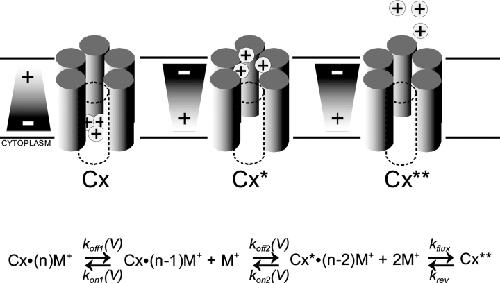XB-IMG-122275
Xenbase Image ID: 122275

|
|
Figure 9. . Gating model for hCx37 hemichannels. Illustration of the gating process for hCx37 hemichannels. At negative potentials (left) the channel is occupied with several polyvalent cations. These bind to a site on the cytoplasmic side of the channel, blocking current flow. At positive potentials (center) the koff for the polyvalent cations becomes significant, the ions are ejected from the site of block, and current is allowed to flow. Polyvalent cations remain at a high local concentration. Upon extended depolarization (right), the local concentration is depleted as well. Upon repolarization, the polyvalent cations bind the channel again, inhibiting current flow (left). A kinetic model for hCx37 hemichannel gating is shown below. Cx is the blocked hemichannel, Cx* is the unblocked hemichannel, Cx** is the unblocked hemichannel free of any polyvalent cations, M+ is a polyvalent cation, n is the minimum number of polyvalent cations needed to inhibit current (see discussion). Image published in: Puljung MC et al. (2004) Copyright © 2004, The Rockefeller University Press. Creative Commons Attribution-NonCommercial-ShareAlike license Larger Image Printer Friendly View |
